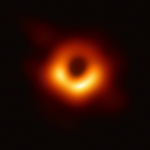The First Image of a Black Hole

by ESR Sam Witte
April 10, 2019 by Bruno Martin
On Wednesday April 10th, 2019, scientists from the Event Horizon Telescope (EHT) unveiled the
first images ever captured of a black hole, objects which until now had only ever been inferred indirectly via their gravitational influence. Black holes are astrophysical objects so dense that not even light can escape their gravitational pull, making them impossible to image directly.
However, for extremely massive black holes such as the supermassive black hole sitting at the center of our galaxy (known as Sagittarius A*), surrounding matter is accelerated both toward and away from the black hole, producing electromagnetic radiation that can be observed
here at Earth using radio telescopes. The characteristic signature of a black hole is thus a ring-like feature in the electromagnetic spectrum surrounding an approximately circular void. This is exactly what was observed by the EHT collaboration in April of 2017, as shown in Fig. 1, while observing the supermassive black hole in the center of the nearby galaxy M87 [1].
The EHT collaboration consists of a large collection of radio telescopes strategically placed in a diverse set of locations, ranging all the way from the South Pole to Greenland, and from Hawaii to the Alps. By synchronizing simultaneous observations made by all telescopes, EHT was successfully able to emulate a single radio telescope nearly the size of Earth, in the process attaining the spatial resolution necessary to probe radio emission around the supermassive black hole of the neighboring galaxy M87.
Initial measurements suggest that gravity in the extreme environments near the horizon of super massive black holes are to a large degree fully consistent with the predictions of general relativity, providing yet another con
rmation of Einstein's theory of gravity. The EHT collaboration will now attempt to make similar measurements of the supermassive black hole in the center of our own galaxy, and improve the image resolution via the inclusion of new
radio telescopes and by taking measurements at higher frequencies.
References
[1] Forthcoming article, The Astrophysical Journal (2019) .

Figure 1: Radio images produced by the EHT collaboration of the super-massive black hole at the center of the M87 galaxy in April of 2017 [1]. Relative colors denote the change in radio intensity.


